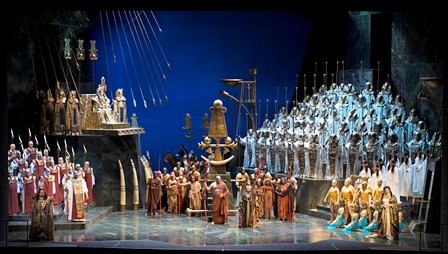
Cincinnati Opera's Season Finale Soars

A splendid “Aida” closed Cincinnati Opera’s 2013 summer festival July 28 at Music Hall. The cast, headed by soprano Latonia Moore as Aida, was superlative, the production stunning and the Cincinnati Symphony Orchestra led by Carlo Rizzi a luxury ensemble in the pit.
Moore, who made a celebrated last-minute debut as Aida at the Metropolitan Opera in New York in 2012, captivated the Cincinnati audience likewise, calibrating her full, rich soprano exquisitely to tender as well as impassioned moments. Tenor Antonello Palombi was well matched as Radamés, exhibiting a sterling voice with plenty of heft. Mezzo-soprano Michelle DeYoung made a fervent Amneris, with baritone Gordon Hawkins a compelling Amanasro and bass Morris Robinson a formidably voiced Ramfis. Filling their roles with distinction were bass Gustav Andreassen as the King of Egypt, tenor M. Andrew Jones as the Messenger and soprano Alexandra Schoeney as the High Priestess.
Designed by Allen Charles Klein and premiered by Florida Grand Opera in 2006 for the opening of Miami’s Carnival Center for the Performing Arts, the production may be best described as Ancient Egyptian modern. The costumes were sumptuous and for much of the opera, members of the chorus – a vibrant presence onstage or off -- were painted gold. Act I opened with Ramfis and the priests announcing the commencement of war with Ethiopia from a large platform on the left with Radamés listening below in the hope that he will be named to lead the Egyptian army. A huge set piece comprising the orb of the sun with golden rays streaming from it hung on the right. Palombi demonstrated his vocal mettle immediately with a soaring “Celeste Aida.”
The temple scene in which Radamès, newly commissioned as the Egyptian general, receives a consecrated sword, featured choreographer Sarah Hairston, painted gold and wearing only a thong beneath a black veil, in a sinuous dance adjoining a fiery altar topped by statues of the gods. The scene to end all, however, was the act II triumphal scene, with the King seated high above the crowd and a chorus of priests ranged on ascending steps opposite him. Golden arrows projected above the set. Amneris (DeYoung) was borne in on an elaborate litter. Radamès made his entry on a rolling platform flanked by troops.
As is the custom with Cincinnati Opera – which spent its first half-century (1920-1972) performing at the Cincinnati Zoo – there were animals in the procession, though not as many as in years past, when an elephant was part of the parade. A hawk was borne by its handler before Radamès’ procession and a pair of horses (retired police horses) and their mounts followed behind. Six onstage herald trumpeters performed the triumphal march antiphonally. The ballet was extremely inventive and performed under changing lights for warm and cool effects. The entrance of the ragtag Ethiopian captives and the confrontation of Aida with her father Amonasro (the Ethiopian king in disguise) were given the utmost drama.
The Nile scene (act III) was gripping for its personal conflict, i.e. Aida’s struggle with her father, who wishes her to extract from Radamès the route to be taken by the Egyptian troops. It was genuinely spooky, too, dark-lit, with over-sized gold vegetation, a temple on the right and a large vessel pulled up to the shore. Moore’s “O Patria Mia” was heart-rending to open the scene, and there was a world of feeling in her exchange with Hawkins as Amonasro. Palombi as Radamès was a touching figure as he realizes what he has done and gives himself up to Amneris and the priests as they emerge from the temple.
It was DeYoung in the last act who sealed the
roiling emotions of the opera as she stood above the tomb where Radamès has
been sentenced to death – with, significantly, an eclipsed sun in the
background – and sang softly “Pace t’imploro” (“Peace, I implore”). Moore and
Palombi were heart-rending as they sang “O terra, addio” below. The audience,
which had been demonstrative throughout the show, responded with a thunderous
ovation.
(first posted at www.ConcertoNet.com)